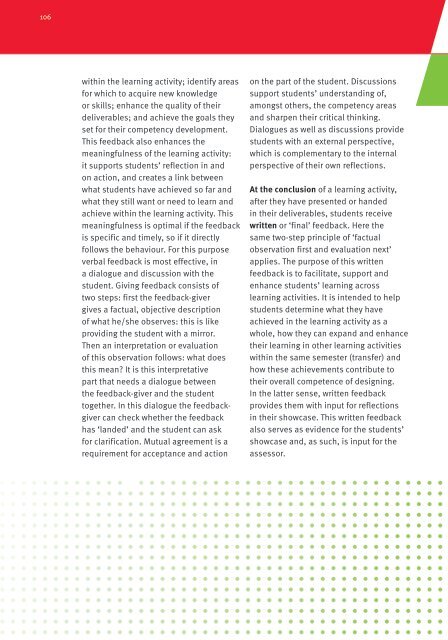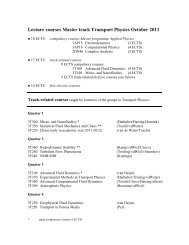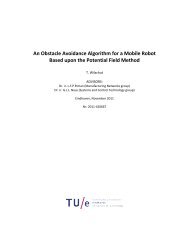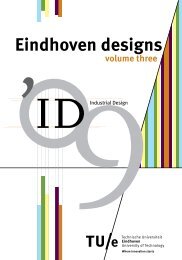Education guide 'Eindhoven designs' - Technische Universiteit ...
Education guide 'Eindhoven designs' - Technische Universiteit ...
Education guide 'Eindhoven designs' - Technische Universiteit ...
Create successful ePaper yourself
Turn your PDF publications into a flip-book with our unique Google optimized e-Paper software.
106<br />
within the learning activity; identify areas<br />
for which to acquire new knowledge<br />
or skills; enhance the quality of their<br />
deliverables; and achieve the goals they<br />
set for their competency development.<br />
This feedback also enhances the<br />
meaningfulness of the learning activity:<br />
it supports students’ reflection in and<br />
on action, and creates a link between<br />
what students have achieved so far and<br />
what they still want or need to learn and<br />
achieve within the learning activity. This<br />
meaningfulness is optimal if the feedback<br />
is specific and timely, so if it directly<br />
follows the behaviour. For this purpose<br />
verbal feedback is most effective, in<br />
a dialogue and discussion with the<br />
student. Giving feedback consists of<br />
two steps: first the feedback-giver<br />
gives a factual, objective description<br />
of what he/she observes: this is like<br />
providing the student with a mirror.<br />
Then an interpretation or evaluation<br />
of this observation follows: what does<br />
this mean? It is this interpretative<br />
part that needs a dialogue between<br />
the feedback-giver and the student<br />
together. In this dialogue the feedbackgiver<br />
can check whether the feedback<br />
has ‘landed’ and the student can ask<br />
for clarification. Mutual agreement is a<br />
requirement for acceptance and action<br />
on the part of the student. Discussions<br />
support students’ understanding of,<br />
amongst others, the competency areas<br />
and sharpen their critical thinking.<br />
Dialogues as well as discussions provide<br />
students with an external perspective,<br />
which is complementary to the internal<br />
perspective of their own reflections.<br />
At the conclusion of a learning activity,<br />
after they have presented or handed<br />
in their deliverables, students receive<br />
written or ‘final’ feedback. Here the<br />
same two-step principle of ‘factual<br />
observation first and evaluation next’<br />
applies. The purpose of this written<br />
feedback is to facilitate, support and<br />
enhance students’ learning across<br />
learning activities. It is intended to help<br />
students determine what they have<br />
achieved in the learning activity as a<br />
whole, how they can expand and enhance<br />
their learning in other learning activities<br />
within the same semester (transfer) and<br />
how these achievements contribute to<br />
their overall competence of designing.<br />
In the latter sense, written feedback<br />
provides them with input for reflections<br />
in their showcase. This written feedback<br />
also serves as evidence for the students’<br />
showcase and, as such, is input for the<br />
assessor.

















